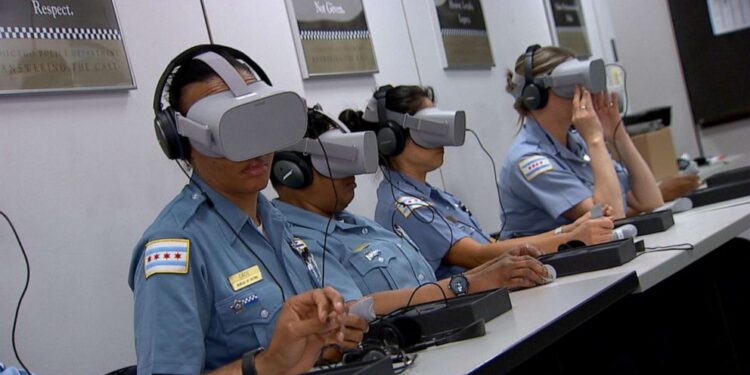Approximately 30 police recruits at Washington’s Criminal Justice Training Center in Burien are participating in a pilot program using virtual reality to prepare for real-life law enforcement encounters, with potential statewide expansion if approved.
The initiative, developed by Axon, the company behind Tasers and police body cameras, aims to supplement traditional academy lectures with immersive, scenario-based learning. One module allows participants to view scenes from the perspective of a person with autism, designed to build empathy before officers respond to calls.
Instructor Jim Morgan said the technology represents a major shift in law enforcement training delivery. “Instead of putting our recruits through PowerPoint lectures that take hours and hours and hours, we can put these into bits of micro-training,” Morgan said. “They go through these experiences to where it’s a memory and they retain up to four times more than from a regular lecture.”
The program could expand to all state police training centers if approved, with projected costs exceeding $1.7 million for outfitting the state’s 212 VR sets.
Morgan said the immersive approach allows recruits to make mistakes and learn in a safe environment. “To be able to do this before they get on the street and have them experience it themselves is groundbreaking,” he said. “By the time they do it live, that motor memory is already locked in.”
Many recruits experience VR for the first time through the program. Nate Clemens, a Seattle Police Department recruit who previously worked as a shipyard manager, joined law enforcement after repeated workplace break-ins and vandalism prompted a conversation with Seattle police about recruitment needs.
“It kept getting broken into and vandalized,” Clemens said. “I went to a meeting with the Seattle Police and found out they needed more officers, and that’s what started me on this path.”
Seattle Police have hired 136 officers this year, sharply increasing from 46 at the same point last year. Clemens expects to graduate in November.
After his first VR experience, he expressed optimism about the technology. “I’ve never used VR before today, [I’m] putting that headset on was the first time,” Clemens said. “I was impressed. I think it could be a very beneficial training tool.”
Simulations include navigating mental-health crises requiring quick decisions about communication, de-escalation, and use of force. Another training module uses virtual Tasers allowing recruits to repeat critical steps as needed.
Axon states its goal is improving officer decision-making and empathy while reducing risk to the public and police. The company has expanded its virtual reality platform nationally, developing training scenarios with input from psychologists, police trainers, and community advocates.
Morgan said Burien campus early results appear promising, with recruits showing stronger retention and confidence after completing VR sessions. “They get repetition after repetition,” he said. “By the time they face the same situation in real life, they’re more prepared and less likely to make errors.”
Clemens said the confidence gained will benefit his upcoming Seattle Police Department role. “It’s different when you’re standing there, even virtually, and you can see how someone else might experience the same moment,” he said. “That’s going to help me be a better officer.”
If approved, the pilot program could become permanent in Washington’s police academy curriculum, expanding virtual reality use as one of modern law enforcement’s newest training tools.







